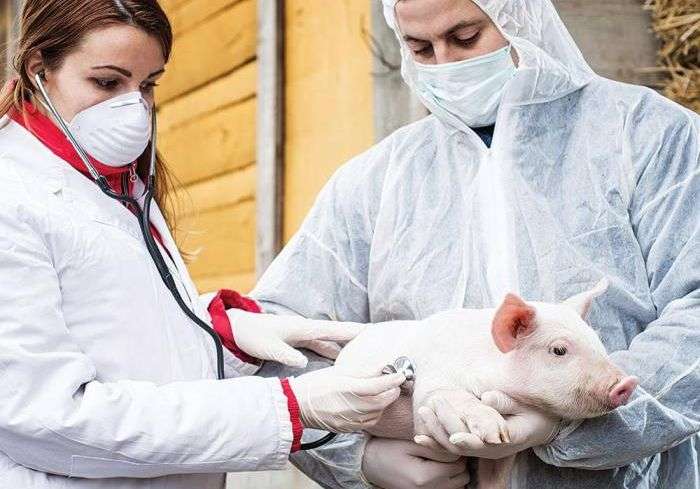A lot of factors have been known to cause diseases to animals, including pigs.
Such factors are poor feeding and management practices, harmful climatic conditions.
Also, the activities of microorganisms such as viruses, rickettsiae, and bacteria, and the harmful effects of parasites which could either be ecto-parasite or endo-parasites.
Microorganisms are in most cases responsible for the symptoms and causes of diseases that are transmissible from sick to healthy animals (infectious diseases).
These organisms are considered as primary invaders, in contrast to certain other species of bacteria that can exert a harmful effect only on an animal whose resistance has already been lowered (secondary infection).
Lowering of resistance is brought about by many environmental factors such as deficient or inadequate rations, but often, it is a primary attack by a virus that weakens the animal (lowers its resistance).
When the body is in this condition, some types of bacteria that are ordinarily harmless become active and give rise to disease (secondary infection).
My submission below is to serve as a guide for practical health control practices in pig production.
The discussion below gives detailed information on the major diseases and parasites of pigs and some others as well as their control measures.
-
Pneumonia & Bronchial pneumonia
The most dangerous bacteria responsible for this are the Pasteurella. This disease results in inflammatory infections of the respiratory tract.
Symptoms
The symptom is difficulty breathing and reduction in the volume of air inspired and expired during each breathing movement.
Others are animals having heavy sides complemented with coughs, loss of appetite, and weight, which may be followed by death.
Treatments
The disease may be treated with antibiotics while a simple way of preventing it is to make available a sheltered wooden sleeping area with straw to eliminate cold at night.
-
Cystitis/nephritis
Cystitis is due to bacterial infection of the bladder and subsequent kidney infection and is particularly prevalent in sows in confined housing.
Symptoms
The disease can be recognized by the presence of pus, and later blood in the urine.
Generally, species of Streptococcus and Corynebacterium are involved, and although large doses of antibiotics can sometimes be beneficial.
The disease is usually fatal due to the difficulty of getting the antibiotics to the site of infection.
Treatments
Antibiotic treatment of the penile sheaths of boars and increasing exercise levels for sows by avoiding close confinement can help prevent the condition.
-
Swine Pox
Swine pox is a virus disease and is transmitted either by direct contact or by ectoparasites such as lice.
Symptoms
Small red areas (about 1.25cm in diameter) appear on the skin around the head, ears, and ventral surface which eventually form scabs.
There is no treatment for swine pox, but although unsightly it rarely causes serious loss and clears up after a short time.
-
Transmissible Gastroenteritis (TGE)
TGE is a viral disease that causes acute diarrhea, vomiting, and early death in young piglets.
It also affects older pigs, causing diarrhea and vomiting but rarely death.
There is no treatment. Infected pigs can be isolated or killed and buried. After infection, the whole herd is likely to be immune.
-
Coccidiosis
Coccidia, which is protozoa are the cause of this disease.
In the process of development, they invade the lining membrane of the intestine.
Reproduction of the organisms is either through the sexual or asexual forms.
When developing, they destroy the cells lining the wall of the intestine during which severe injury is caused to the bowel.
Symptoms
The symptom of this disease in young pigs is bloodstained diarrhea (dysentery).
Under severe invasion, the animal feces become evil-smelling and contain blood and mucus.
The animal soon becomes emancipated and this will be accompanied by death.
Treatments
Since the cause of this disease is normally through the feeding of contaminated feeds and water, maintenance of high standard of hygiene serves as an effective means of control.
The addition of coccidiostat low levels will also be effective. In cases that are not too severe, the use of sulfur containing drugs serves as effective means of treatment.
-
Trypanosomiasis
This disease is normally acute or chronic and is caused by blood parasites belonging to the class called Flagellata.
Infection is transmitted by voting flies of the species of Glossina which spread the disease by attacking a healthy animal after having sucked blood from one that was infected.
The casual protozoan organisms are Trypanosoma vivax, T brucei and T Simiae.
Symptoms
Symptoms of the disease are anemia, loss of condition, and great weakness. There is also swelling in animals, particularly in the reproductive organs.
Treatments
The disease can be successfully treated with drugs such as Naganol, Samorenil or Berenil provided that is caught in the early stages.








